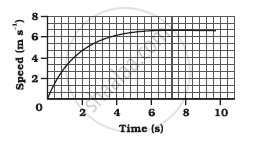Advertisements
Advertisements
Question
What can you say about the motion of a body whose distance-time graph is a straight line parallel to the time axis ?
Solution
The body is not moving because it is not changing its position with respect to any stationary object.
APPEARS IN
RELATED QUESTIONS
What can you say about the motion of an object if its speed-time graph is a straight line parallel to the time axis?
The speed-time graph for a car is shown in the following figure:

- Find how far the car travels in the first 4 seconds. Shade the area on the graph that represents the distance travelled by the car during the period.
- Which part of the graph represents uniform motion of the car?
Fill in the following blank with suitable word :
The slope of a speed-time graph of a moving body gives its………………………..
A cyclist is travelling at 15 m s-1. She applies brakes so that she does not collide with a wall 18 m away. What deceleration must she have ?
A student draws a distance-time graph for a moving scooter and finds that a section of the graph is horizontal line parallel to the time axis. Which of the following conclusion is correct about this section of the graph?
The slope of the distance-time graph at any point gives______.
If we denote speed by S, the distance by D and time by T, the relationship between these quantities is
The distance between Bholu’s and Golu’s house is 9 km. Bholu has to attend Golu’s birthday party at 7 o’clock. He started from his home at 6 o’clock on his bicycle and covered a distance of 6 km in 40 minutes. At that point, he met Chintu and spoke to him for 5 minutes and reached Golu’s birthday party at 7 o’clock. With what speed did he cover the second part of the journey? Calculate his average speed for the entire journey.
The area under velocity time graph represents ______.
What do you infer if
- Distance – time graph is a straight line.
- The velocity-time graph is curved.
- Displacement time is zigzag.
